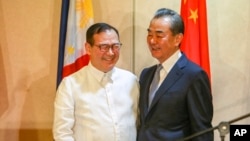China is exploring ways to build new infrastructure in a second-tier Philippine port city as a link in its Belt-and-Road Initiative for expanding Chinese trade in Southeast Asia and the South Pacific.
Chinese Foreign Minister Wang Yi visited the Philippine port of Davao City Monday to talk for an hour with the host country’s President Rodrigo Duterte, according to the Philippine presidential office website. Wang said Sino-Philippine economic cooperation can “expand to new areas, including projects of the Belt and Road Initiative,” China’s official Xinhua News Agency reported.
Filipinos have expected China to act on its October 2016 pledge of $24 billion in aid and investment. They worry especially because the Philippines had struggled to get along with Beijing due to a maritime sovereignty dispute.
A rehab of Davao’s deep-water but otherwise small, ramshackle port would increase business for the 1.6 million-person city that anchors a resource-rich but largely impoverished southern island. Chinese shippers could use Davao as an import-export base and call there along the way to countries further south.
“At the end of the day they’re saying that it’s beneficial for China to have improving trade with many of these countries and if you have better infrastructure, it will help trade both ways,” said Rajiv Biswas, Asia-Pacific chief economist with the research firm IHS Markit.
Belt, road and sea
China kicked off its Belt-and-Road initiative in 2013 to open trade foreign routes by investing in the infrastructure development of 100 other countries. The “scope” is expanding from initial recipient countries in continental Eurasia to regions including the South Pacific, Xinhua noted.
Davao City, which is on a gulf near the Philippines’ Pacific coast, would make sense as a place for Chinese to use for shipping minerals, said Christian de Guzman, vice president and senior credit officer with Moody’s in Singapore.
“Mindanao itself I think has been a recipient of I wouldn’t say significant but a number of Chinese investments over the years related to the extraction of mineral resources, mining basically,” de Guzman said.
“China is increasingly active globally in trying to secure some of these mineral resources,” he said. Davao port development, he added, “could be tied to the fact that Mindanao has been a recipient of these investments in the past.”
Adding to China's southbound focus, Indonesia received $23.3 billion in Belt-and-Road contracts in April this year. The Belt-and-Road is also opening a “vast market” for South Pacific nations, Xinhua said this month after Samoa signed an agreement to join China’s initiative.
“If they have plans for extending the maritime silk road towards Indonesia and the South Pacific islands, then Davao would be a good place,” said Jay Batongbacal, University of the Philippines international maritime affairs professor. He suggested that imports as exports could be sent through Davao. “Although it’s a major port compared to Manila, it’s less busy,” he said.
Tough but receptive political climate
Duterte, also former mayor of Davao City, opened channels for Chinese investment pledges by setting aside the maritime dispute that hampered relations from 2012 until he took office in 2016. Davao “happens to be the home city of Duterte,” Batongbacal said. In China, he added, “they know they can do more in that city, faster, with him.”
While Filipinos welcome investment in a $169 billion, five-year infrastructure renewal effort hatched under Duterte, their country and China still dispute sovereignty over tracts of the South China Sea. China leads in military infrastructure buildup in the sea’s contested Spratly Islands.
“The southern port development plan in Davao is interesting because it’s part of the Philippine plans to encourage more Chinese investment, but it comes at a time when the Philippines is quite uncomfortable with the military activities and buildup in the Spratly Islands immediately off [the coast],” said Stuart Orr, business and law professor at Deakin University in Australia.
Some skeptics of Sino-Philippine relations are impatient for China to actualize the pledges made to date. In August, Wang and the Philippine finance secretary agreed to fast-track two railway projects.
But analysts caution the Philippines against owing China a hard-to-pay debt as Belt-and-Road recipients Pakistan and Sri Lanka do. Unpaid debt has prompted China and other partner countries to consider localizing more projects and making bids more transparent.
Due to “debt trap” fears, Batongbacal said, “the [Philippine] government is much more keenly aware of what to avoid.”









